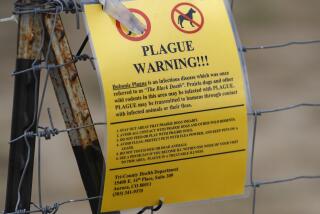Old Scourge of Leprosy Has Flared Anew in Pacific Isles
- Share via
POHNPEI, Micronesia — On remote, palm-fringed atolls where island life still moves to the Pacific’s timeless rhythms, an age-old scourge--leprosy--has flared anew. On some islands, half the people are lepers.
Local officials, the U.S. government and international health specialists disagree over how much money is needed to fight the disease in this U.S.-controlled territory, formerly known as Ponape. Some dispute that it is a true epidemic. But none deny the outbreak is serious.
“At one point, we thought leprosy was not a problem. But the incubation period takes years,” Dr. Kiosi Aniol, the local government health coordinator, told a reporter. “We became aware of new cases, and started looking, and found quite a few.”
On the outlying atolls of Kapingamarangi and Pingelap, rings of islands 500 and 200 miles from this district capital, 560 leprosy cases are reported among the combined population of 900, Aniol says.
Kapingamarangi, a thatched-roof community of tiny coconut isles 3,000 miles southwest of Hawaii, has long been regarded as a picture-postcard remnant of the old South Seas. Now it has another distinction, as the site of what a U.S. government leprosy specialist, Dr. John R. Trautman, describes as probably “the most significant (leprosy) epidemic, percentage-wise, in the history of the world.” Many of its handsome island people have been disfigured and incapacitated.
One victim, Ultrick Alex, 31, said he came here several years ago from his native Pingelap, where “so many people have it.”
“We don’t know how it began. I first noticed I had it in second grade,” he told a reporter.
“Now I can’t work. These are no good,” he said, looking down at hands permanently curled into the useless claw shape that afflicts many advanced cases.
Although incurable, leprosy can be arrested with drugs. But the immediate challenge for the Federated States of Micronesia (FSM) government is to determine just how many cases it is dealing with.
The 607 islands of the Federated States are spread over 1 million square miles of the western Pacific. Part of the American-administered U.N. Trust Territory of the Pacific Islands, the islands may gain semi-independence later this year after 41 years of U.S. control.
Aniol said government surveys thus far have found 1,322 cases among the Federated States’ 85,000 people, 852 of them in Pohnpei state, which includes Kapingamarangi and Pingelap.
“But Truk state has half the FSM population and more infected areas than the other states. We believe that once our survey is completed, we will find many more cases there,” he said. The screening program’s results will not be known for several months, however.
An estimated 11 million people worldwide have leprosy, mostly in equatorial Asia, Africa and South America. The bacterial disease, mentioned in the Bible, was unknown in the Pacific islands until the early 20th Century.
It generally develops only after years of close contact with an active case, beginning with bumps or patches on the skin, and later attacking peripheral nerves, causing numbness and sometimes leading to paralysis, twisted hands or slack feet.
Victims, feeling no pain in numb extremities, sometimes suffer burns or infections serious enough to require amputation.
The Federated States’ leprosy attack rate of 15 per 1,000 population surpasses the World Health Organization standard for an epidemic--10 per 1,000. But U.S. officials note that “epidemic” implies a sudden outbreak, and leprosy has been endemic here for generations, although the latest upsurge is traced to the early 1960s.
“It’s not that there are any more cases than six months ago, but that the reporting of cases is better,” said one U.S. official, speaking on condition of anonymity.
In an interview, Janet McCoy, U.S. high commissioner for the Trust Territory, pointed out that leprosy is controllable, through daily doses of dapsone or other drugs that make it less contagious.
“But we are not taking it lightly,” McCoy said at her headquarters on the island of Saipan, 1,100 miles northwest of here.
The World Health Organization has allocated $265,000 for leprosy drug purchases for five years in the Federated States, and the U.S. Congress has appropriated $200,000 for training and administrative expenses for the anti-leprosy effort.
Aniol said the money is not enough. The WHO drugs will last only a year, he said, and the Federated States had asked Washington for $2 million for a combined leprosy-tuberculosis program.
One reason the U.S. government hesitated to supply more funds: Auditors had questioned some of the uses made of $1.6 million appropriated for an anti-cholera drive in Truk state in 1983.
More to Read
Sign up for Essential California
The most important California stories and recommendations in your inbox every morning.
You may occasionally receive promotional content from the Los Angeles Times.












